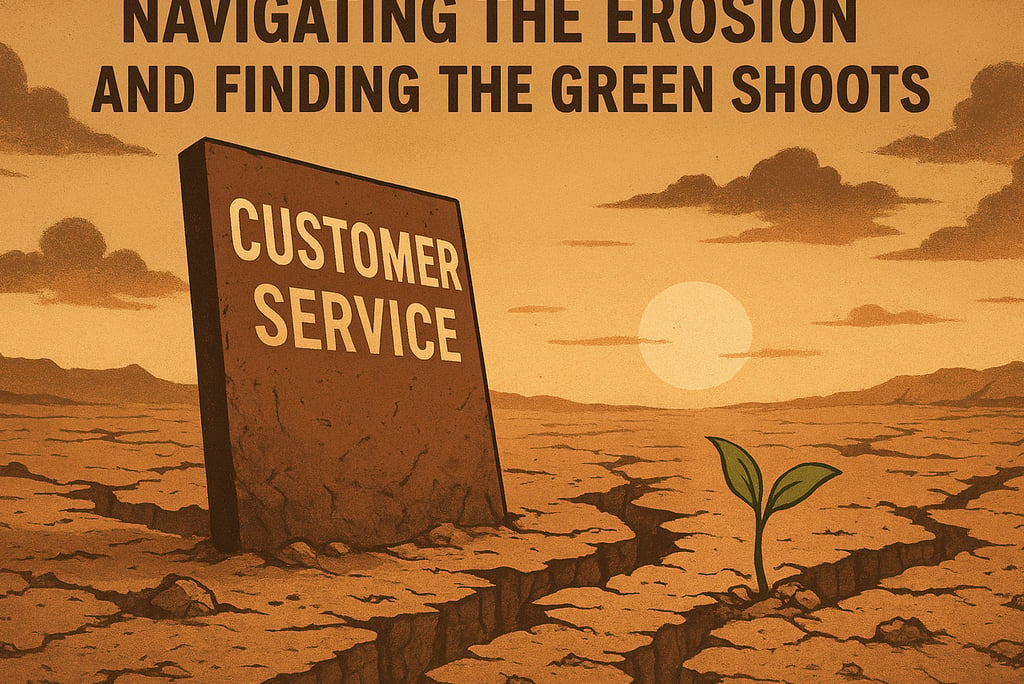Teachable moments #57 - A Heart-to-Heart on Service: Navigating the Erosion and Finding the Green Shoots
Ang Woon Jiun
10/13/20253 min read


A Heart-to-Heart on Service: Navigating the Erosion and Finding the Green Shoots
Hello everyone,
I've been reflecting lately on the state of the "Service Landscape". Not the beautiful, manicured kind, but the one defined by human interaction, customer care, and the simple act of helping. And honestly, it feels like we're standing on ground that's started to erode.
I'm talking about those moments we've all experienced: the automated voice maze that steals your lunch break, the feeling of being just a ticket number, or the sheer exhaustion of trying to reach a human who can actually solve your problem.
The Great Service Erosion: What Happened?
It feels like a perfect storm of efficiency, scale, and the pressure of the bottom line has chipped away at the quality we once expected:
The Rise of the Robot (and the Fall of Empathy): Automation is a necessity, but when it replaces human judgment and warmth entirely, we lose the essential ingredient of service: connection. We're optimized for speed, but at what cost to understanding?
The Ghosting of Accountability: When you deal with a sprawling system, it's easy for the responsibility to dissolve. Who owns the customer's problem? Often, the answer is frustratingly vague, leaving the customer feeling dismissed.
The Exhausted Employee: We can't talk about service erosion without mentioning the people on the front lines. Burnout, overwhelming workloads, and feeling unsupported are direct contributors to a lack of genuine care. When employees are treated like cogs, it's impossible for them to treat customers like valued individuals.
It’s a deeply human problem. We are all customers, and we all crave the feeling of being seen, heard, and valued.
But Here's the Silver Lining (The Green Shoots)
This erosion, painful as it is, has created something crucial: a moment of clarity and a massive opportunity for those willing to lean into genuine service. The low bar has become the biggest advantage.
Here is where the bright side shines through:
The Exponential Value of the Human Touch: Because bad service is now so common, the simple act of providing good, empathetic service is a huge differentiator. A genuine apology, a quick solution from a real person, or even a moment of understanding cuts through the noise and creates fierce loyalty. People don't just remember the fix; they remember the feeling.
The Clarity of Friction Points: All that erosion points us directly to where we need to build. Every frustrating self-service portal or dead-end email chain is a data point screaming, "Fix this process!" This gives leaders a clear mandate to invest in workflows that empower their teams and delight their customers.
A New Standard for Leadership: This landscape demands a new kind of leadership: one focused on Service-First Culture. It’s about recognizing that the employee experience is the customer experience. Companies that prioritize well-being, training, and trust in their service teams are the ones who will thrive. They are the ones laying the new foundation.
Technology as an Enabler, Not a Replacement: We are learning to use AI and automation not to replace humans, but to supercharge them. Imagine a world where the robot handles the repetitive drudgery, freeing the human expert to tackle the complex, emotional, and high-value problems. That is the true silver lining of this tech era.
The service landscape has changed, yes, and the terrain is rougher. But the very roughness highlights the beauty of what can be built next.
The companies that will win the next decade are those who see the erosion not as a disaster, but as a chance to plant something infinitely stronger and more human in its place.
What is your reflection? When was the last time a company's service genuinely surprised you, and what made it stand out? Let's discuss.
Fondly,
Ang Woon Jiun
Managing Partner
Follow Us
Let us easily communicate, share ideas, and build relationships all over the world.
Sign Up For News And Exclusives
© 2024 to 2025 The Talent Craftsmen. All rights reserved. UEN T25LL0478E
